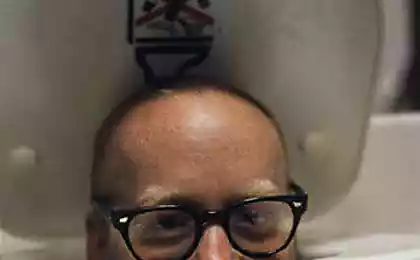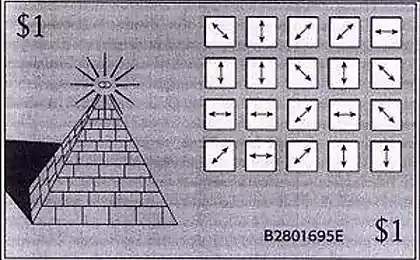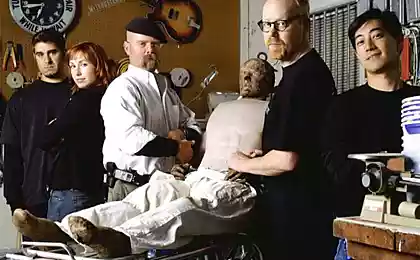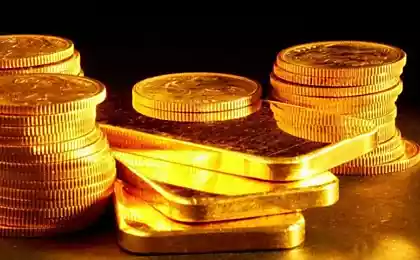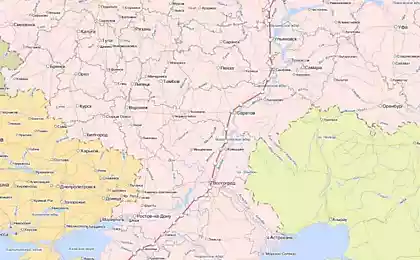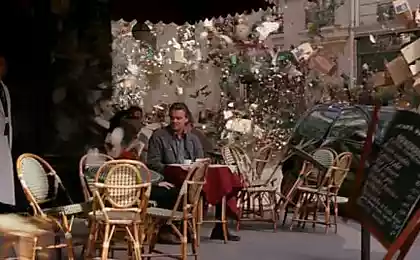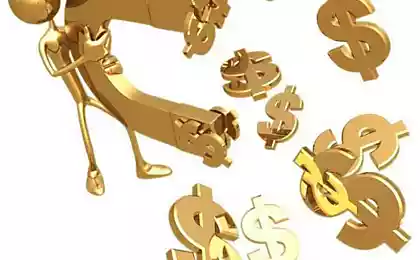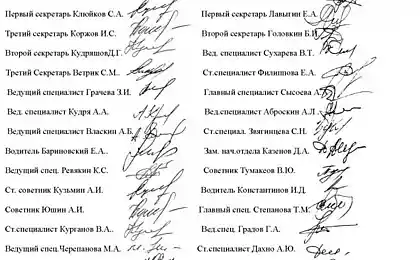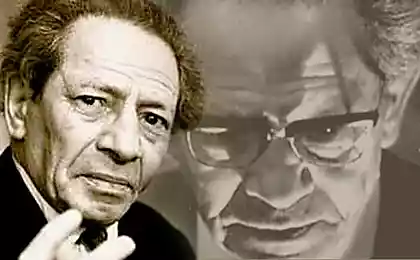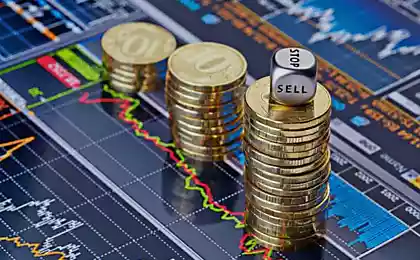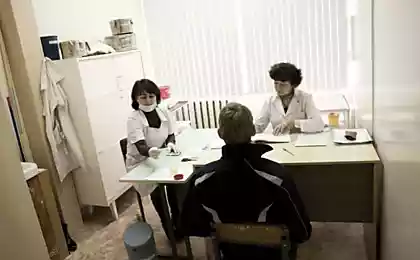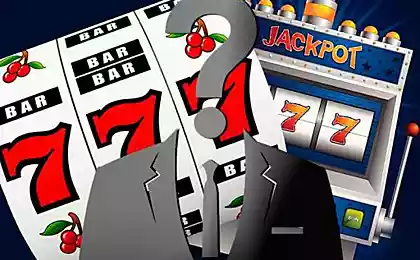1480
Equipment for authentication of money
For many centuries, from the time of the invention of money, there is opposition to the issuers and currency counterfeiting. The first use increasingly sophisticated methods of protection, the second is how they forge. Modern banknotes have security features are so complex that they can not be checked without special hardware. In addition, frequently required to provide authentication without any human intervention, for example, payment terminals or in banks in the automated processing of large amounts of cash.
Let us consider in detail how modern protected currency, how the authentication (validation), and that of the equipment used for this purpose.
22 picture + 2 video + text
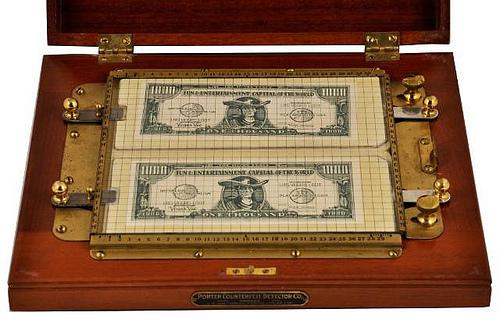
Human or signs
Methods of protection against forgery invented by a huge amount. But unfortunately, not all of them are suitable for automated validation. Either protective element seriously considered and represented in digital form, or no clear criteria "test Pass / Fail", or both together. So the best validator remains watchful eye of the expert.
Human or signs are very diverse, interesting, and invented every year more and more. In good, their description is drawn to a separate article, but as we continue to go after all of the equipment, limited to the short list.
Watermark. Images created portions of paper of different density, can be seen through. Perhaps the most famous priznak.Zaschitnaya thread. Metal or polymer tape introduced into the thickness of the paper. It can be simple or diving. Diving thread repeatedly comes to the surface of the sheet and immersed obratno.Mikropechat. Figure notes may contain tiny symbols, usually denomination or a bank or a smaller elements, which are distinguishable only under uvelicheniem.Zaschitnye fiber. Scraps of colored yarns in the stock. The fiber can be as simple or woven strands of several different tsvetov.Mikroperforatsiya. Laser punched straight identical small holes that make up an image or inscription. Like watermarks found in the lumen. Relief holes should not be felt by the fingers, the paper around them should not be obuglena.Relefnaya printing. Graffiti, distinguishable by touch. Runs as a utilitarian function (the mark for the blind), and the protection function poddelki.Kipp effect. Corrugated surface portion on the side faces of the corrugations applied an image that is visible only when viewed at an acute uglom.Sovmeschayuschiesya image. Figure, the various elements which are located on opposite sides of the sheet. When viewed against the light of the need to precisely match each other and give the whole izobrazhenie.Orlovskaya printing. Thin lines, the color of which varies along the line without visible interruptions and superimposing the colors. Normal color printing will inevitably result in this case, the error register is tsvetov.Tisnenie foil. Figure made of metal foil pressed onto the surface bumagi.MVC. Moire patterns of different colors, which are visible when tilted banknoty.OVI. Optically variable ink. The element changes its color depending on the angle at which it smotret.Gologramma. The element that gives a three-dimensional holographic image that is rotated by tilting banknoty.Mashinochitaemye signs
And what to consider and verify the machines? A set of computer-readable authenticity features are much more modest.
Dimensions of the banknote
Dimensions of the banknote, strictly speaking, do not relate to the security features, but most of the detectors check them first. First of all, it allows you to immediately cut off the trash: scraps of notes, foreign objects stuck together and folded money. And secondly, it is a simple, but fairly reliable way to detect the currency and denomination.
Dimensions are tested optically, scanning in transmitted light. If the unit is not equipped with a full-size scanner, it can detect only one of the dimensions by measuring the time of overlapping sensors bill when it is pulled through the mechanism. Also, by weakening the light flux, the device detects double banknote.
The visible image
The image of the banknote in visible light is obtained by scanning, either in transmitted light or in reflected (each side separately), or so, and so. The unit can not check the whole surface, but only a few specific areas. In this case it is sufficient individual sensors, each of which is an optocoupler: + LED photodiode.
For reliable validation requires the entire image, and in this case, the line of photodetectors similar to the ones that are in conventional scanners. Resolution lines may lie in a range from 10 to 200 DPI, and the increase of resolution does not always lead to an increase in the recognition quality.
Scanning can be performed in one color (usually red, sometimes white) and can be in full color. In the second case, the scanner comprises a plurality of color channels. Not always is the standard RGB. Basic colors are selected on the basis of spectra paint recognizable currency. Color may be more than three: for example, red (640 nm), green (525 nm), blue (~450 nm) and dark red (~ 750 nm, almost on the boundary with infrared) in which the clearly visible features of the pattern USD .
Infrared image
The image in infrared light (880-940 nm) is one of the basic machine-readable features. When printing banknotes are special, the so-called metameric paint. Figure made such paints may look uniform in visible light, but IR be clearly dark and light areas.

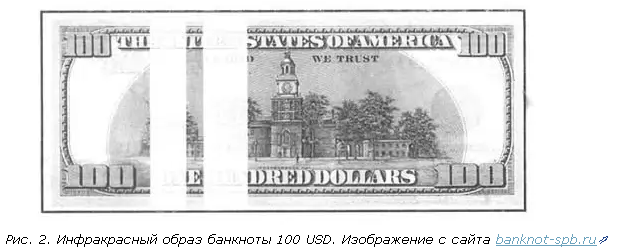

Furthermore, in the infrared scan on the lumen can reliably detect watermarks, security tapes and metallized elements banknote. Infrared scanning allows to determine the optical density of the paper, using it as yet another sign of the audited, or simply reject the twin sheets.
Ultraviolet mark
As one of the security features comprise tags banknotes deposited phosphors which, when irradiated with ultraviolet light in the visible spectrum. There phosphors in all colors of the rainbow, so that the note under UV looks very nice.

Dollars look much more modest, a narrow strip of lights, the color depends on the denomination.

But the euro sparkles with all the colors.

Fluorescent also have protective properties of fiber (at RUB and EUR), and different fibers have different color of light. The woven fibers on the ruble a thread of light, and the second is not, because of what looks like the broken fiber. Another security feature is the absence of paper luminescence background. Conventional writing paper comprises optical brighteners, due to which it glows under ultraviolet light blue. Money is printed on unbleached paper that gives background glow.
To test UV labels validator equipped with a UV lamp or LEDs (360-380 nm). Glow marks captured photodetectors visible spectrum, which closed filters, UV cut-off primary. The simplest detectors check only the absence of background luminescence of paper, devices higher level remove the full scan. Glow protective fibers hardly checked by virtue of their small size and location of the irregularity.
Magnetic labels
In some parts of the bill applied paint are magnetic. For example, Russian rubles modifications up to 2004 a number of the banknote magnetic (green). In 2010 rubles modification magnetic properties are certain parts of the image.

US Dollars are several magnetic zones bizarre.
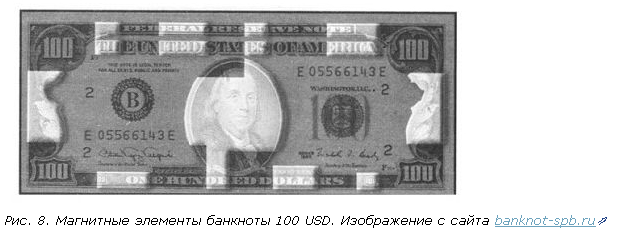
On euro magnet security thread number and an image.

Magnetic tags are divided into "hard" and "soft." First performed using magnetic materials, and can store its own magnetization. "Soft" label demagnetized immediately when the external field. To detect the magnetic read heads used labels, similar to the conventional tape. Bits for validators are generally broad (2-5 cm) to capture a larger area. To read the "hard" marks first banknote is pulled over by a permanent magnet, and then head over to catch residual magnetization.
Cpetselement "And»
Conventional phosphors emit light having a wavelength longer than the excitation radiation. For example, when irradiated with ultraviolet illumination visible light. There is a class of substances called anti-Stokes phosphors for which the law does not hold. On the properties of anti-Stokes phosphors based action of the security element "AND". [4]
When the illumination of the intense infrared light (with a wavelength of 940-960 nm), it begins to emit in the green region of the spectrum (~ 520 nm). On the anti-Stokes rubles labels are located on the front lower left (gray digits nominal) and the right (gray background nominal).

There are fluorescent labels with more complex test procedures, such as requiring laser irradiation and luminous in the infrared range.
Cpetselement «M»
This security element is a paint which has different COEFFICIENT absorption at different portions of the spectrum in the IR region. If the bill to cover alternating light 940 nm and 850 nm, the element "M" will appear flashing (when viewed in infrared light, again). [5]
On rubles modifications until 2001, is an element present in the form of a point, tape or portion of the image. Of more recent modification of reliable data available.
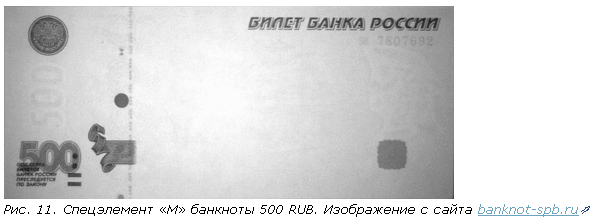
On the US dollar has similar properties Treasury seal.

Secret signs
To complicate the work of counterfeiters, published information is not all security features. There classified security features that are not known to the general public, and are checked only by the Central Bank. An indirect source of information about them may serve as patents. To protect against counterfeiting can be used much more interesting.
For example, the identification of the characteristics of the buildup and the afterglow of the phosphor. [11] or the use of electroluminescent. [12] or the introduction of pulp fibers having magnetic properties. [13] or metallic elements having a well-defined resonance in the microwave range. [14] Or even nanodiamonds (no kidding!). [15]
Goznak for machine manufacturers sell spetsalno tester special signs (at the factory LOMO in St. Petersburg). He works as a USB device. What's inside - is not known for the reliability of the entire device is sealed.
Devices banknote processing
Look-detectors
Viewing counterfeit detector only visualizes the security features, and a decision on whether or not a genuine banknote by the operator. On the one hand the instrument turns as simple and cheap, but on the other - requires certain skills.
UV detector represents one or more UV lamps, often with a magnifier and scale grid. Luminescence security features check "by eye".
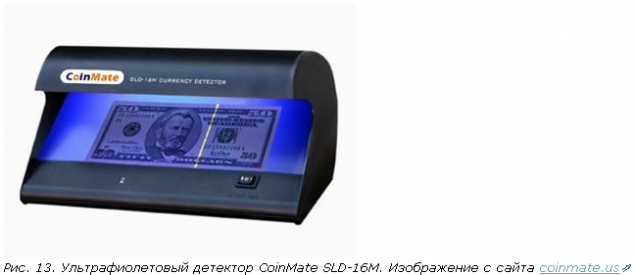
The infrared detector is designed a little harder. It contains infrared illumination working area, the camera with the appropriate filter and a display showing the image from the camera. To control spetselementa "M" employs two groups of illumination, with different wavelengths, which are alternately switched. Spetselement thus appears flashing.
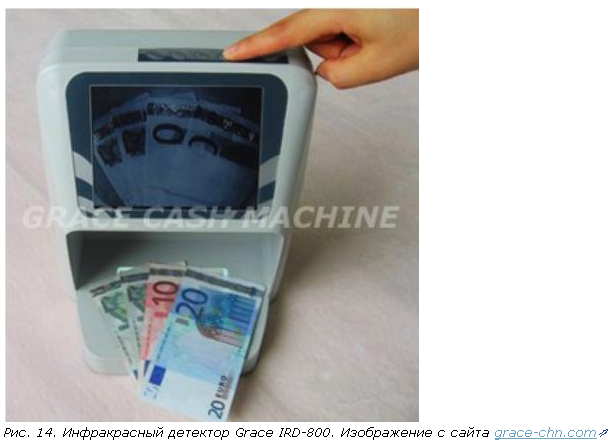
There are combined (IR + UV) devices. In addition, the look-detectors can be equipped with Caged (to study suspicious fragments "near"), detectors of magnetic labels and similar accessories.
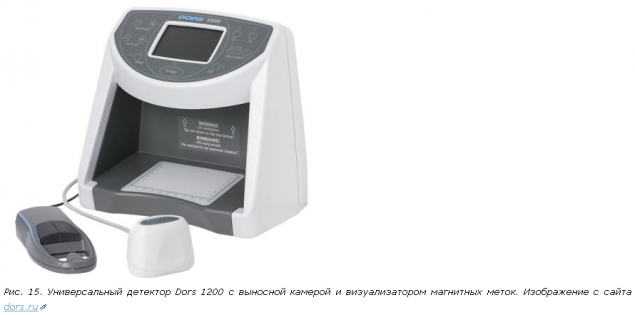
Automatic detectors
Automatic detection does not require any special knowledge of the brain. Simply insert the bill, it picks up the detector, extends through the tract, scans, analyzes and verdict: fake or real.
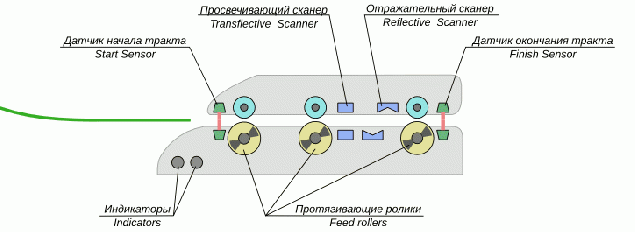
Fig. 16. The principle of automatic detection of authenticity most simple detectors have only several single photo detectors and thus several separate scan lines of the image, usually in the infrared range. More advanced models read the full image of the banknote using the photodetector line. In addition, magnetic sensors may be present, and UV light.
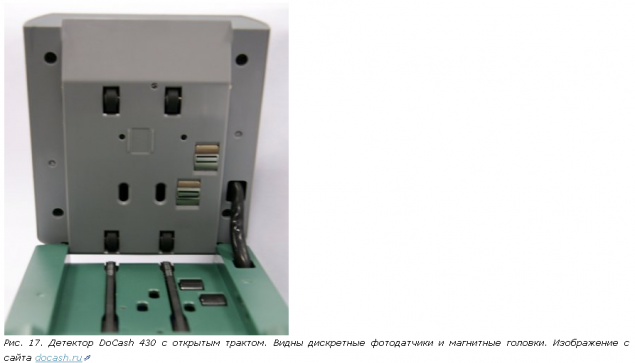
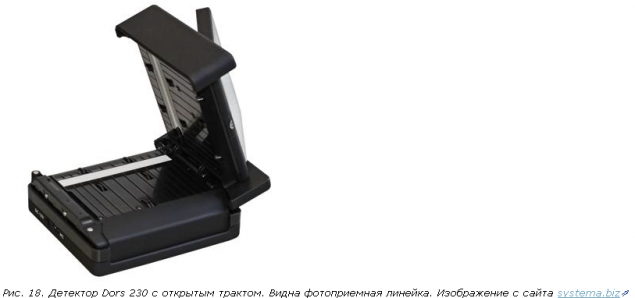
Meters and sorters
The main disadvantage of automatic detectors - low speed operation, they take notes at a time. And if a lot of money? For such cases, invented banknote counters: in the pack is charged at once, and it quickly (at a rate of 600-1500 pcs. Per minute) slistyvaet bills one by one, carefully laying recalculated pack to output pocket.
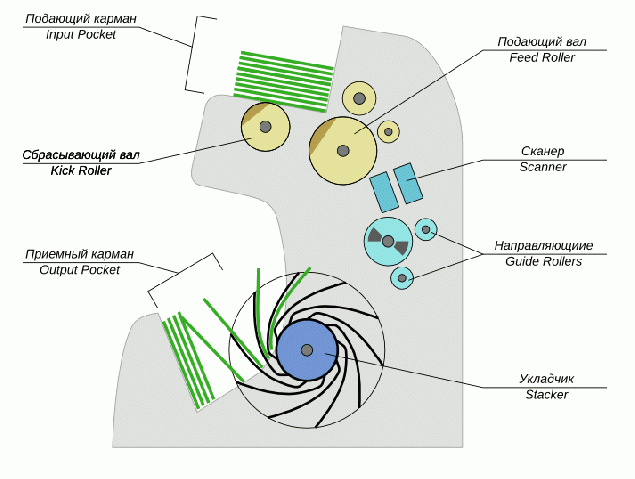
Fig. 19. The principle of the banknote counter There are two basic ways to pack slistnut.
Mechanical. Before tract are clips from the "sticky" rubber rollers, and of thick rubber. In the simplest case, a pack is located above the rollers are pushed into the path of the lower bill, and that bill included one at the entrance to the path located rollers rotating in the opposite direction to push the extra bills obratno.Vakumny. A stack is pressed against the apertured belt under it creates negative pressure, and stick to the banknote tape that drags them in the path.
It is worth saying that authentication has not all counters. The simplest models are not able to anything other than the mechanical conversion and rejection stuck together notes or sheets that are very different in size (eg, fragments).
Counters higher class already have UV sensors and magnetic labels. More expensive cars perform a full scan of the bill in the infrared range. Since then, the counter is already able to determine the currency and the denomination of bills passing through it. You can count a bundle of money and immediately know how much it bills of each denomination, and what is the total amount.
Counters are high-end scanning in the visible, IR and UV ranges, read the magnetic label and measure the thickness of the paper mechanical or capacitive method. The latter feature allows to distinguish the new banknotes by the worn, torn and glued. Thus, the counter can lead to sort of currency denomination, orientation, identity and deterioration.
These counters typically have two receiving pockets: basic and otbrakovochny that allows not to interrupt the count when it detects suspicious banknote.
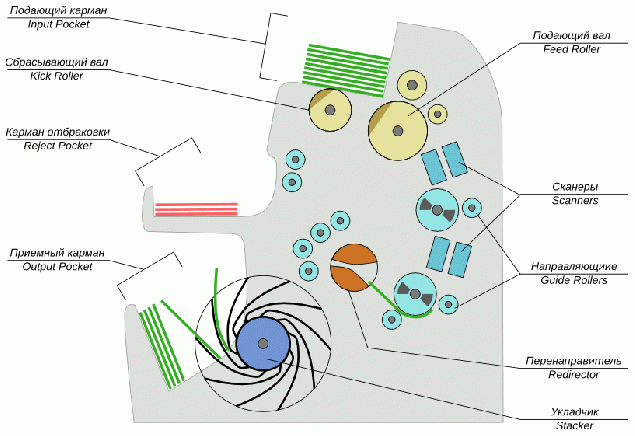
Fig. 20. The principle of operation of the counter-dvuhkarmannogo banknote sorter From dvuhkarmannogo counter trace their ancestry mnogokarmannye devices, often called the banknote sorter. The simplest of them look like a normal desktop computer, a little "bloated" in height, with several receiving pockets.

And in the top price segment there are real monsters: the car holding a table (or even more), with dozens of pockets, with the possibility of extension, with additional modules for packing money, with validation of all that is possible with preference and poet. < br />
Video presentation countable-sorting machines JetScan MPS 4200
Acceptor
Acceptor used in shopping and gaming machines, payment terminals, ATMs and other self-service systems. They provide a welcome cash, nominal definition, validation and stacking banknotes in a locked drawer. Requirements for self-validators are quite high: almost always used two-way multi-channel optical scanner, UV and magnetic detectors. Acceptor equipped with different systems to prevent exposure to the mechanism and deception. For example, the detector sees the presence of foreign objects fishing line or tape, for which a bill can be pulled back. To protect against vandalism bill validators can be supplied with protective shields (Shutter).
Mechanisms for receiving the money are divided into pokupyurnye and burst. The first "eat" one bill, the supply is short edge first. Burst mechanisms immediately take wad of bills, recount, determine denominations and validated. Such bill validators installed mainly on cash machines, although there are the usual tips pokupyurnye receivers, you can take a pack immediately (up to 20 banknotes), and then submit it into one sheet.
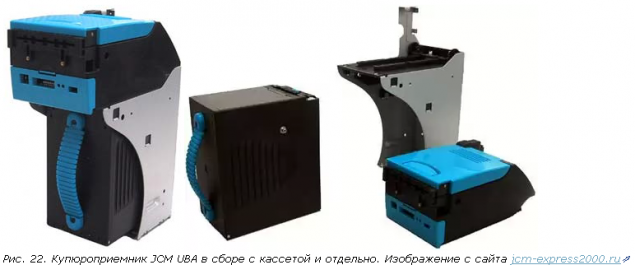
The introduced bill after passing through the validator fall into deponentnoe Department (Escrow). The volume of this compartment may vary from 1 to all bills introduced by the pack. If you cancel the operation of the banknote escrow return. If the operation is confirmed, the banknotes stacked in the cassette (Cashbox) - locked and sealed box.
Source:
Let us consider in detail how modern protected currency, how the authentication (validation), and that of the equipment used for this purpose.
22 picture + 2 video + text

Human or signs
Methods of protection against forgery invented by a huge amount. But unfortunately, not all of them are suitable for automated validation. Either protective element seriously considered and represented in digital form, or no clear criteria "test Pass / Fail", or both together. So the best validator remains watchful eye of the expert.
Human or signs are very diverse, interesting, and invented every year more and more. In good, their description is drawn to a separate article, but as we continue to go after all of the equipment, limited to the short list.
Watermark. Images created portions of paper of different density, can be seen through. Perhaps the most famous priznak.Zaschitnaya thread. Metal or polymer tape introduced into the thickness of the paper. It can be simple or diving. Diving thread repeatedly comes to the surface of the sheet and immersed obratno.Mikropechat. Figure notes may contain tiny symbols, usually denomination or a bank or a smaller elements, which are distinguishable only under uvelicheniem.Zaschitnye fiber. Scraps of colored yarns in the stock. The fiber can be as simple or woven strands of several different tsvetov.Mikroperforatsiya. Laser punched straight identical small holes that make up an image or inscription. Like watermarks found in the lumen. Relief holes should not be felt by the fingers, the paper around them should not be obuglena.Relefnaya printing. Graffiti, distinguishable by touch. Runs as a utilitarian function (the mark for the blind), and the protection function poddelki.Kipp effect. Corrugated surface portion on the side faces of the corrugations applied an image that is visible only when viewed at an acute uglom.Sovmeschayuschiesya image. Figure, the various elements which are located on opposite sides of the sheet. When viewed against the light of the need to precisely match each other and give the whole izobrazhenie.Orlovskaya printing. Thin lines, the color of which varies along the line without visible interruptions and superimposing the colors. Normal color printing will inevitably result in this case, the error register is tsvetov.Tisnenie foil. Figure made of metal foil pressed onto the surface bumagi.MVC. Moire patterns of different colors, which are visible when tilted banknoty.OVI. Optically variable ink. The element changes its color depending on the angle at which it smotret.Gologramma. The element that gives a three-dimensional holographic image that is rotated by tilting banknoty.Mashinochitaemye signs
And what to consider and verify the machines? A set of computer-readable authenticity features are much more modest.
Dimensions of the banknote
Dimensions of the banknote, strictly speaking, do not relate to the security features, but most of the detectors check them first. First of all, it allows you to immediately cut off the trash: scraps of notes, foreign objects stuck together and folded money. And secondly, it is a simple, but fairly reliable way to detect the currency and denomination.
Dimensions are tested optically, scanning in transmitted light. If the unit is not equipped with a full-size scanner, it can detect only one of the dimensions by measuring the time of overlapping sensors bill when it is pulled through the mechanism. Also, by weakening the light flux, the device detects double banknote.
The visible image
The image of the banknote in visible light is obtained by scanning, either in transmitted light or in reflected (each side separately), or so, and so. The unit can not check the whole surface, but only a few specific areas. In this case it is sufficient individual sensors, each of which is an optocoupler: + LED photodiode.
For reliable validation requires the entire image, and in this case, the line of photodetectors similar to the ones that are in conventional scanners. Resolution lines may lie in a range from 10 to 200 DPI, and the increase of resolution does not always lead to an increase in the recognition quality.
Scanning can be performed in one color (usually red, sometimes white) and can be in full color. In the second case, the scanner comprises a plurality of color channels. Not always is the standard RGB. Basic colors are selected on the basis of spectra paint recognizable currency. Color may be more than three: for example, red (640 nm), green (525 nm), blue (~450 nm) and dark red (~ 750 nm, almost on the boundary with infrared) in which the clearly visible features of the pattern USD .
Infrared image
The image in infrared light (880-940 nm) is one of the basic machine-readable features. When printing banknotes are special, the so-called metameric paint. Figure made such paints may look uniform in visible light, but IR be clearly dark and light areas.



Furthermore, in the infrared scan on the lumen can reliably detect watermarks, security tapes and metallized elements banknote. Infrared scanning allows to determine the optical density of the paper, using it as yet another sign of the audited, or simply reject the twin sheets.
Ultraviolet mark
As one of the security features comprise tags banknotes deposited phosphors which, when irradiated with ultraviolet light in the visible spectrum. There phosphors in all colors of the rainbow, so that the note under UV looks very nice.

Dollars look much more modest, a narrow strip of lights, the color depends on the denomination.

But the euro sparkles with all the colors.

Fluorescent also have protective properties of fiber (at RUB and EUR), and different fibers have different color of light. The woven fibers on the ruble a thread of light, and the second is not, because of what looks like the broken fiber. Another security feature is the absence of paper luminescence background. Conventional writing paper comprises optical brighteners, due to which it glows under ultraviolet light blue. Money is printed on unbleached paper that gives background glow.
To test UV labels validator equipped with a UV lamp or LEDs (360-380 nm). Glow marks captured photodetectors visible spectrum, which closed filters, UV cut-off primary. The simplest detectors check only the absence of background luminescence of paper, devices higher level remove the full scan. Glow protective fibers hardly checked by virtue of their small size and location of the irregularity.
Magnetic labels
In some parts of the bill applied paint are magnetic. For example, Russian rubles modifications up to 2004 a number of the banknote magnetic (green). In 2010 rubles modification magnetic properties are certain parts of the image.

US Dollars are several magnetic zones bizarre.

On euro magnet security thread number and an image.

Magnetic tags are divided into "hard" and "soft." First performed using magnetic materials, and can store its own magnetization. "Soft" label demagnetized immediately when the external field. To detect the magnetic read heads used labels, similar to the conventional tape. Bits for validators are generally broad (2-5 cm) to capture a larger area. To read the "hard" marks first banknote is pulled over by a permanent magnet, and then head over to catch residual magnetization.
Cpetselement "And»
Conventional phosphors emit light having a wavelength longer than the excitation radiation. For example, when irradiated with ultraviolet illumination visible light. There is a class of substances called anti-Stokes phosphors for which the law does not hold. On the properties of anti-Stokes phosphors based action of the security element "AND". [4]
When the illumination of the intense infrared light (with a wavelength of 940-960 nm), it begins to emit in the green region of the spectrum (~ 520 nm). On the anti-Stokes rubles labels are located on the front lower left (gray digits nominal) and the right (gray background nominal).

There are fluorescent labels with more complex test procedures, such as requiring laser irradiation and luminous in the infrared range.
Cpetselement «M»
This security element is a paint which has different COEFFICIENT absorption at different portions of the spectrum in the IR region. If the bill to cover alternating light 940 nm and 850 nm, the element "M" will appear flashing (when viewed in infrared light, again). [5]
On rubles modifications until 2001, is an element present in the form of a point, tape or portion of the image. Of more recent modification of reliable data available.

On the US dollar has similar properties Treasury seal.

Secret signs
To complicate the work of counterfeiters, published information is not all security features. There classified security features that are not known to the general public, and are checked only by the Central Bank. An indirect source of information about them may serve as patents. To protect against counterfeiting can be used much more interesting.
For example, the identification of the characteristics of the buildup and the afterglow of the phosphor. [11] or the use of electroluminescent. [12] or the introduction of pulp fibers having magnetic properties. [13] or metallic elements having a well-defined resonance in the microwave range. [14] Or even nanodiamonds (no kidding!). [15]
Goznak for machine manufacturers sell spetsalno tester special signs (at the factory LOMO in St. Petersburg). He works as a USB device. What's inside - is not known for the reliability of the entire device is sealed.
Devices banknote processing
Look-detectors
Viewing counterfeit detector only visualizes the security features, and a decision on whether or not a genuine banknote by the operator. On the one hand the instrument turns as simple and cheap, but on the other - requires certain skills.
UV detector represents one or more UV lamps, often with a magnifier and scale grid. Luminescence security features check "by eye".

The infrared detector is designed a little harder. It contains infrared illumination working area, the camera with the appropriate filter and a display showing the image from the camera. To control spetselementa "M" employs two groups of illumination, with different wavelengths, which are alternately switched. Spetselement thus appears flashing.

There are combined (IR + UV) devices. In addition, the look-detectors can be equipped with Caged (to study suspicious fragments "near"), detectors of magnetic labels and similar accessories.

Automatic detectors
Automatic detection does not require any special knowledge of the brain. Simply insert the bill, it picks up the detector, extends through the tract, scans, analyzes and verdict: fake or real.

Fig. 16. The principle of automatic detection of authenticity most simple detectors have only several single photo detectors and thus several separate scan lines of the image, usually in the infrared range. More advanced models read the full image of the banknote using the photodetector line. In addition, magnetic sensors may be present, and UV light.


Meters and sorters
The main disadvantage of automatic detectors - low speed operation, they take notes at a time. And if a lot of money? For such cases, invented banknote counters: in the pack is charged at once, and it quickly (at a rate of 600-1500 pcs. Per minute) slistyvaet bills one by one, carefully laying recalculated pack to output pocket.

Fig. 19. The principle of the banknote counter There are two basic ways to pack slistnut.
Mechanical. Before tract are clips from the "sticky" rubber rollers, and of thick rubber. In the simplest case, a pack is located above the rollers are pushed into the path of the lower bill, and that bill included one at the entrance to the path located rollers rotating in the opposite direction to push the extra bills obratno.Vakumny. A stack is pressed against the apertured belt under it creates negative pressure, and stick to the banknote tape that drags them in the path.
It is worth saying that authentication has not all counters. The simplest models are not able to anything other than the mechanical conversion and rejection stuck together notes or sheets that are very different in size (eg, fragments).
Counters higher class already have UV sensors and magnetic labels. More expensive cars perform a full scan of the bill in the infrared range. Since then, the counter is already able to determine the currency and the denomination of bills passing through it. You can count a bundle of money and immediately know how much it bills of each denomination, and what is the total amount.
Counters are high-end scanning in the visible, IR and UV ranges, read the magnetic label and measure the thickness of the paper mechanical or capacitive method. The latter feature allows to distinguish the new banknotes by the worn, torn and glued. Thus, the counter can lead to sort of currency denomination, orientation, identity and deterioration.
These counters typically have two receiving pockets: basic and otbrakovochny that allows not to interrupt the count when it detects suspicious banknote.

Fig. 20. The principle of operation of the counter-dvuhkarmannogo banknote sorter From dvuhkarmannogo counter trace their ancestry mnogokarmannye devices, often called the banknote sorter. The simplest of them look like a normal desktop computer, a little "bloated" in height, with several receiving pockets.

And in the top price segment there are real monsters: the car holding a table (or even more), with dozens of pockets, with the possibility of extension, with additional modules for packing money, with validation of all that is possible with preference and poet. < br />
Video presentation countable-sorting machines JetScan MPS 4200
Acceptor
Acceptor used in shopping and gaming machines, payment terminals, ATMs and other self-service systems. They provide a welcome cash, nominal definition, validation and stacking banknotes in a locked drawer. Requirements for self-validators are quite high: almost always used two-way multi-channel optical scanner, UV and magnetic detectors. Acceptor equipped with different systems to prevent exposure to the mechanism and deception. For example, the detector sees the presence of foreign objects fishing line or tape, for which a bill can be pulled back. To protect against vandalism bill validators can be supplied with protective shields (Shutter).
Mechanisms for receiving the money are divided into pokupyurnye and burst. The first "eat" one bill, the supply is short edge first. Burst mechanisms immediately take wad of bills, recount, determine denominations and validated. Such bill validators installed mainly on cash machines, although there are the usual tips pokupyurnye receivers, you can take a pack immediately (up to 20 banknotes), and then submit it into one sheet.

The introduced bill after passing through the validator fall into deponentnoe Department (Escrow). The volume of this compartment may vary from 1 to all bills introduced by the pack. If you cancel the operation of the banknote escrow return. If the operation is confirmed, the banknotes stacked in the cassette (Cashbox) - locked and sealed box.
Source:

